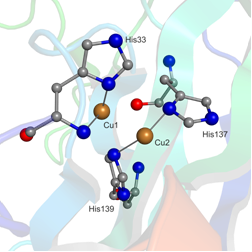Bioinspired hydroxylation of methane
Efficient technology to convert natural gas into liquids, such as methanol, is highly desirable for an efficient use of the remaining natural gas reservoirs. The selective oxidation of methane to methanol is a research topic that links homogeneous and biological catalysis. In nature microorganisms are able to catalyse the oxidative degradation of methane with high efficiency. In focus in this research field are therefore the synthesis and structural characterization of bioinspired methane monooxygenase (MMO) models based on Fe and Cu metal sites.

Fig.1: The active center of the pMMO.
The determination of the crystal structure of the particulate methane monooxygenase (pMMO) indicates that the catalytic function is based on a di-copper site (Figure 1). Suitable models bearing the [Cu-O-Cu]2+ subunit are therefore tested as functional mimics and investigated with respect to the binding and activation of O2 as well as to mono- and dioxygenase activity.
Fig. 2: From a novel dicopper(I) complex to a CuII-O-CuII centre of bioinorganic relevance. The figure displays the structure of the parent state (left), and the UV-vis absorption (middle) and RR spectrum of the of the oxo complex (right; gray line, 16O; black line, 18O).
Research goals
- Kinetic data and theoretical calculations concerning these model compounds will be analysed in terms of a mechanistic model in an attempt to reach a common molecular description of the chemical and biological catalytic processes.
- Furthermore, following the successful investigations on dioxygen activation at dinuclear copper(I) complexes (Figure 1) ("Dinuclear Copper Complexes Based on Parallel β-Diiminato Binding Sites and their Reactions with O2 - Evidence for a Cu-O-Cu Entity" P. Haack, C. Limberg, K. Ray, B. Braun, U. Kuhlmann, P. Hildebrandt, C. Herwig, Inorg. Chem. 2011, 50, 2133-2142.), our studies are expanded to heterobimetallic Cu,Fe-complexes as “hybride models” combining features of both the iron-based soluble MMO and the copper-based pMMO.
- We furthermore apply novel concepts for the immobilisation of such molecular catalysts, to finally create a material series from molecular to solid catalysts containing [Cu-O-Cu] sites, thus linking biological to homogeneous and heterogeneous catalysis.

